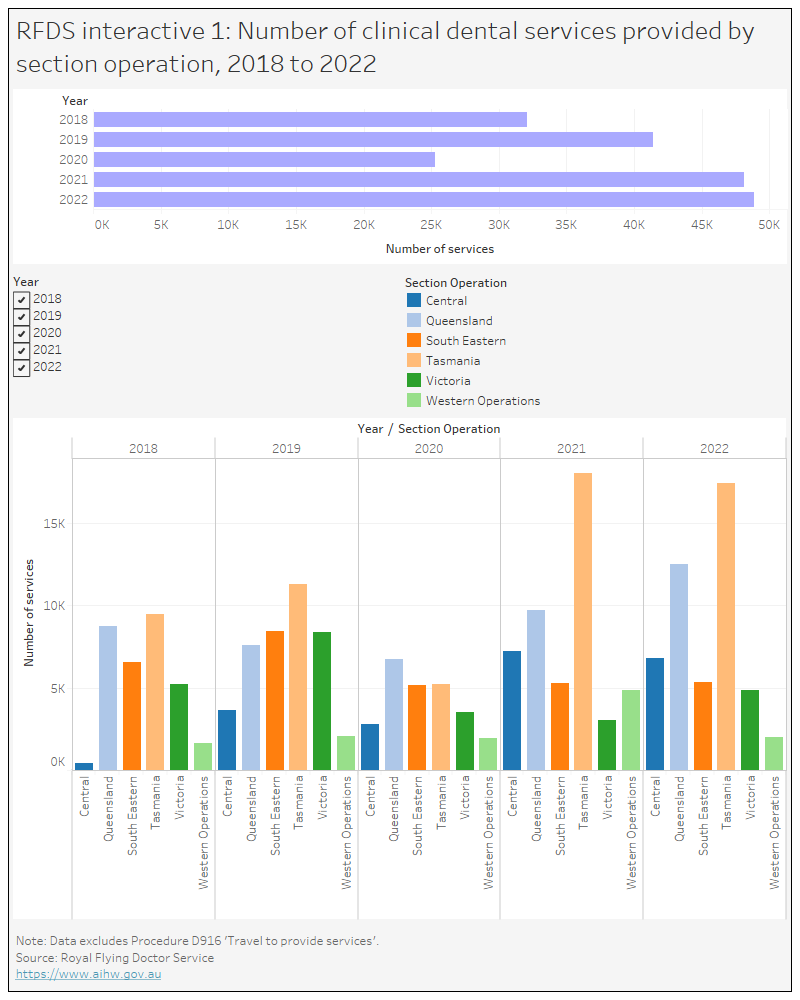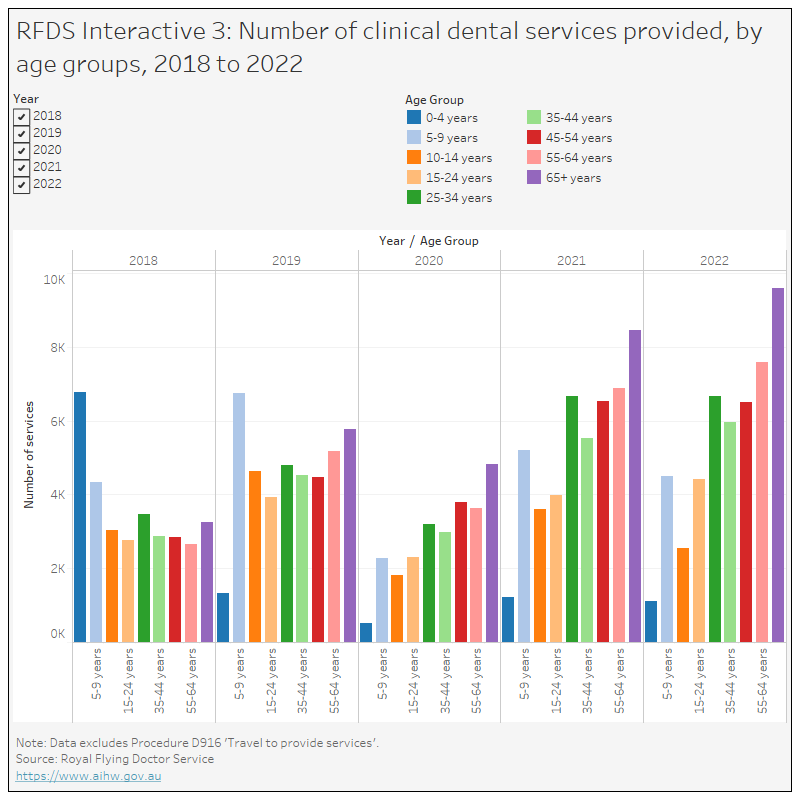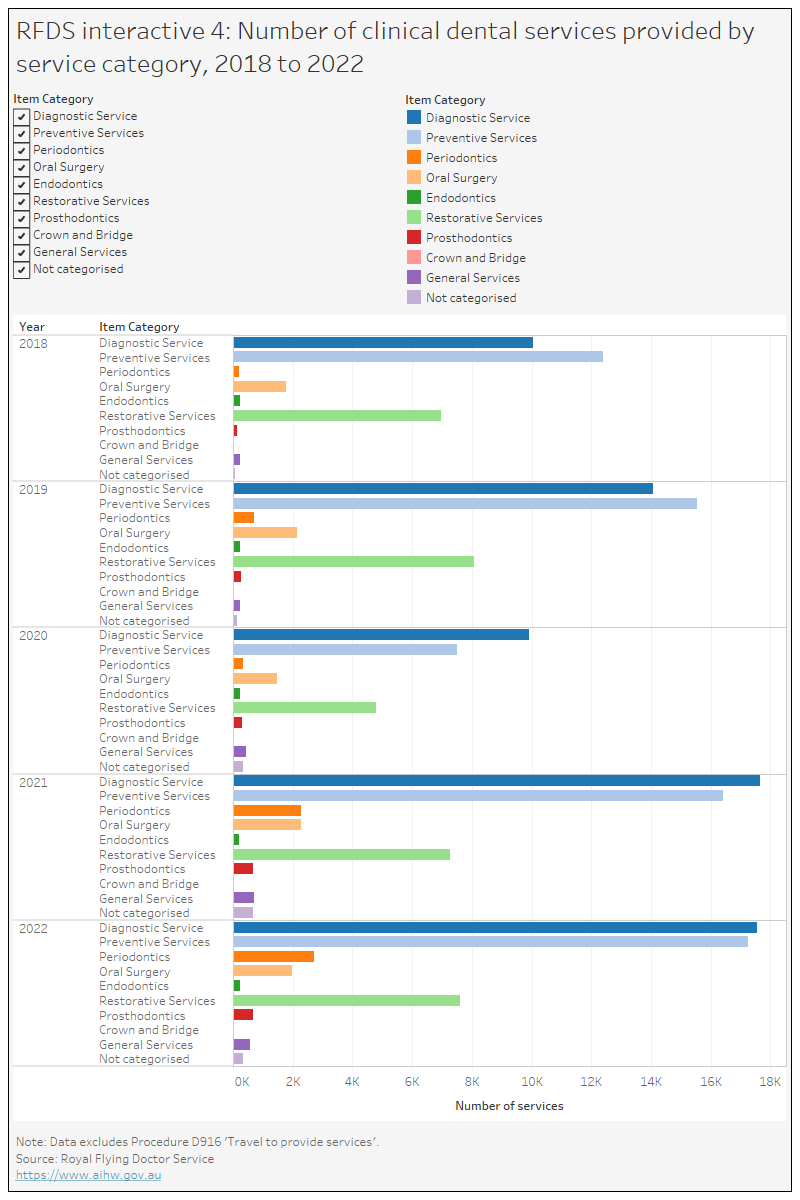People living in regional and remote areas
Overall, people living in regional and remote areas of Australia have poorer oral health than those living in Major cities (COAG 2015), and oral health status generally declines as remoteness increases. People living in rural areas have access to fewer dental practitioners than their city counterparts, which, coupled with longer travel times and limited transport options to services, affects the oral health care that they can receive (COAG 2015; Bishop & Laverty 2015).
People living in Remote and Very remote areas are also more likely to smoke and drink at risky levels. They have reduced access to fluoridated drinking water and face increased costs of healthy food choices and oral hygiene products. These risk factors contribute to this population’s overall poorer oral health (COAG 2015).
Royal Flying Doctor Service
The Royal Flying Doctor Service (RFDS) provides a comprehensive range of primary healthcare services throughout Australia. After recognising that a large proportion of people living in remote and rural Australia do not have access to a regular dental service, the RFDS established their dental service designed to support communities in country Australia. These services are provided using ‘fly-in fly-out’, mobile and outreach delivery models and are funded by the Commonwealth of Australia, state governments, private investments or the use of donor funds (Gardiner et al 2020).
The RFDS are committed to providing primary healthcare services to those in need, and, using ‘access to a primary healthcare service within a 60-minute drive time’ as one measure of reasonable access, identified that close to 119,000 people did not have access to general dental services (RFDS 2022). This included around 11,500 people in the West Pilbara region, around 10,300 in the Alice Springs region and around 9,500 in the Daly-Tiwi-West Arnhem region (RFDS 2022).
The following data has been sourced from the RFDS administrative patient dataset (unpublished) and covers the period 2018 to 2022. Due to differences in reporting periods and analysis methodology, figures presented here may not match those presented by the RFDS.
The RFDS provided over 25,000 clinical dental services each year between 2018 and 2022 to individuals in regional and remote areas across Australia. The number of clinical dental services provided ranged from around 25,300 in 2020, a year affected by the COVID-19 pandemic, to around 48,900 in 2022.
Explore the data further in RFDS interactive 1.
This figure shows the number of clinical dental services provided by the Royal Flying Doctor Service (RFDS) by section operation (location) from 2018 to 2022. In 2022, the total number of clinical dental services provided was 48,856, with 17,429 of these being provided in Tasmania.

See Data tables: Priority populations for data tables.
Each year between 2018 and 2022, more clinical dental services were provided to females than males.
Of the nearly 48,900 clinical dental services the RFDS provided in 2022, around:
- 21,100 clinical dental services were provided to males
- 23,800 clinical dental services were provided to females
- 4,000 clinical dental services were provided to those whose sex was not reported.
Explore the data further in RFDS interactive 2.
This figure shows the number of clinical dental services provided by the Royal Flying Doctor Service (RFDS) by sex from 2018 to 2022. Females received more services than males during this period. In 2022, females received 23,750 clinical dental services provided by the RFDS.

See Data tables: Priority populations for data tables.
Oral health generally deteriorates with age (refer to Introduction). As such, older people may require more clinical dental services, perhaps receiving a diagnostic, preventive and restorative service, during their dental visits than what younger people require, perhaps receiving a preventive service only. For example, data from the National Study of Adult Oral Health 2017–18 (unpublished) shows that, on average, around 2 in 3 adults aged 65 years and over needed a filling compared to around 1 in 3 children aged 5–14 years (refer to Dental care interactive 9).
The RFDS provide clinical dental services to people of all ages. The data presented in RFDS interactive 3 reflects the number of clinical dental services provided rather than the number of people who received clinical dental services. In 2020, 2021 and 2022, more clinical dental services were provided to those aged 65 years and over than any other age group. Across these same years, fewer clinical dental services were provided to children aged 0-4 years than any other age group.
Explore the data further in RFDS interactive 3.
This figure shows the number of clinical dental services provided by the Royal Flying Doctor Service (RFDS) by age group from 2018 to 2022. In 2022, children aged 5-9 years received 4,500 clinical dental services and adults aged 65 years and over received 9,601 clinical dental services provided by the RFDS.

See Data tables: Priority populations for data tables.
Between 2018 and 2022, the leading service categories were diagnostic services and preventive services followed by restorative services.
In 2022, the RFDS provided around:
- 17,500 diagnostic services
- 17,300 preventive services
- 7,600 restorative services.
Explore the data further in RFDS interactive 4.
This figure shows the number of clinical dental services provided by the Royal Flying Doctor Service (RFDS) by service category from 2018 to 2022. Diagnostic, preventative and restorative services were most commonly provided. In 2022, 17539 clinical dental services were provided by the RFDS.

See Data tables: Priority populations for data tables.
Bishop LM & Laverty MJ 2015. Filling the gap: Disparities in oral health access and outcomes between metropolitan and remote and rural Australia. Canberra: Royal Flying Doctor Service of Australia.
Bishop L, Gardiner F, Spring B, Gale L, Schofield Z and Quinlan F, 2022. Best for the Bush: rural and remote health base line 2022. Royal Flying Doctor Service of Australia. Viewed: 5 October 2023
COAG (Council of Australian Governments) Health Council 2015. Healthy Mouths, Healthy Lives: Australia’s National Oral Health Plan 2015–2024. Adelaide: South Australian Dental Service.
Gardiner, FW, Richardson, A, Gale, L, et al. Rural and remote dental care: Patient characteristics and health care provision. Aust J Rural Health. 2020; 28: 292– 300. doi.org/10.1111/ajr.12631
Royal Flying Doctor Service (n.d.). Oral Health. Viewed: 21 September 2023.


